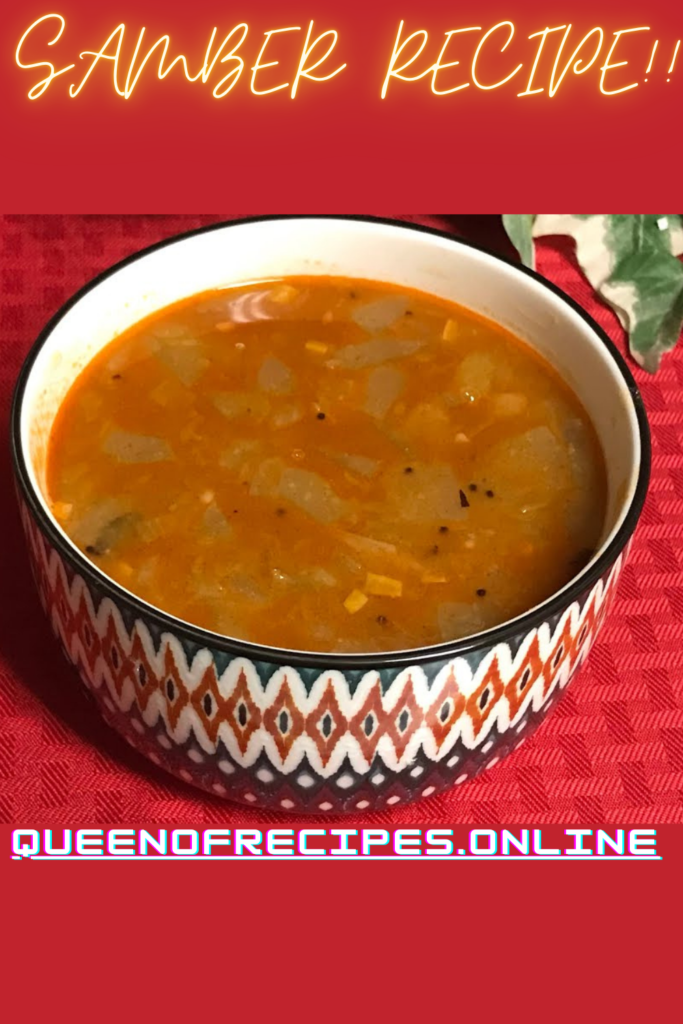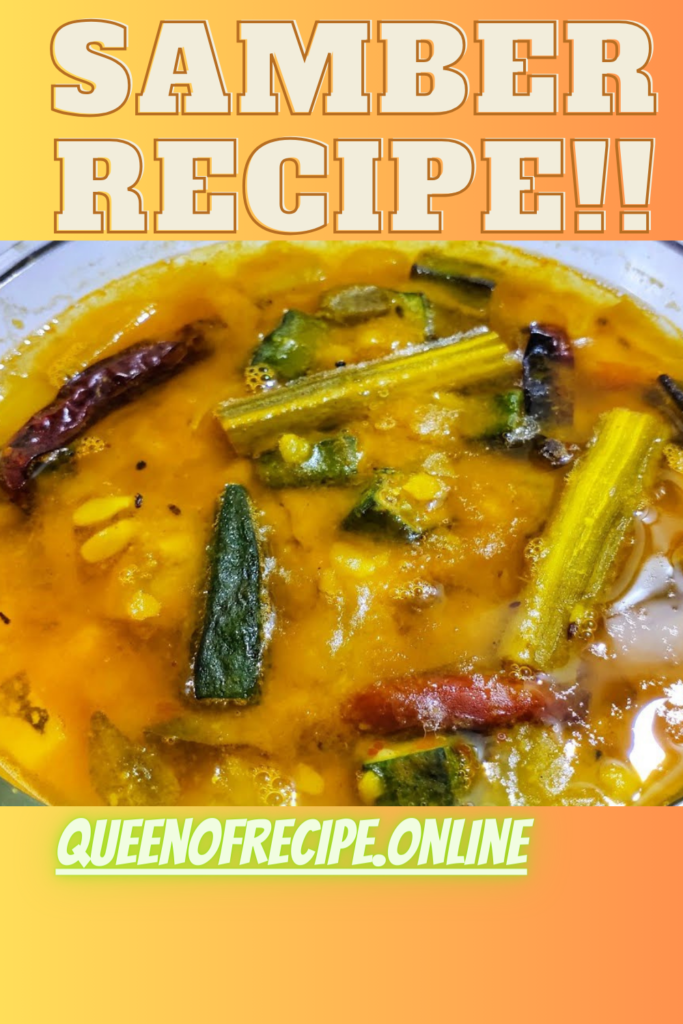Table of Contents
About Samber.
Sambar, often spelled as “Samber” in some regions, is a classic South Indian dish that holds a special place in the hearts of millions. It’s a flavorful and wholesome stew that’s both nutritious and delicious. Samber is traditionally made with a combination of lentils, vegetables, and a blend of aromatic spices and tamarind. It’s known for its slightly tangy taste, rich aroma, and vibrant colors.
This iconic South Indian dish is a staple in many households and is enjoyed with various accompaniments like rice, dosa (a type of crepe), idli (steamed rice cakes), or vada (fried lentil dumplings). Samber is not only a tasty comfort food but also a nutritious way to incorporate a variety of vegetables and lentils into the diet.
To make Samber at home, you’ll need a mix of lentils, vegetables, and a blend of spices. Here’s a basic recipe:
Ingredients for making Samber:
For the Samber Paste:
- 1/4 cup split pigeon peas (toor dal)
- 1/4 cup split red gram (masoor dal)
- 1 small onion, chopped
- 1 small tomato, chopped
- 2-3 dry red chilies
- 1 teaspoon cumin seeds
- 1/2 teaspoon fenugreek seeds
- 1/2 teaspoon turmeric powder
- A small piece of tamarind (approx. 1 tablespoon tamarind paste)
- 2 tablespoons grated coconut (optional)
- Water for soaking and grinding
For the Samber:
- 1 cup mixed vegetables (like carrots, beans, eggplant, drumsticks)
- 1 small onion, chopped
- 1 small tomato, chopped
- 2-3 green chilies, slit
- A few curry leaves
- 1/2 teaspoon mustard seeds
- 1/2 teaspoon cumin seeds
- 1/4 teaspoon asafoetida (hing)
- 1/2 teaspoon turmeric powder
- 1 tablespoon cooking oil
- Salt to taste
- Chopped fresh coriander leaves for garnish
Instructions for making Samber:
- Prepare the Samber Paste:
- Wash and soak both dals (toor dal and masoor dal) in water for 30 minutes.
- In a pan, add a little oil and sauté the chopped onion and tomato until they turn soft.
- Add dry red chilies, cumin seeds, fenugreek seeds, turmeric powder, and tamarind paste. Sauté briefly.
- Allow this mixture to cool, and then grind it into a smooth paste along with grated coconut and soaked lentils. Add water as needed to make a thick paste.
- Cook the Lentils and Vegetables:
- In a pressure cooker, cook the soaked and rinsed lentils along with the mixed vegetables until they become soft and mushy. This usually takes about 3-4 whistles on medium heat.
- Prepare the Samber:
- In a large pot, heat oil and add mustard seeds. When they splutter, add cumin seeds, asafoetida, and curry leaves.
- Add chopped onions and green chilies. Sauté until the onions become translucent.
- Combine and Cook:
- Add the chopped tomatoes and sauté until they become soft and pulpy.
- Pour in the prepared Samber paste and cook for a few minutes, stirring continuously.
- Add Cooked Lentils and Vegetables:
- Pour in the cooked lentils and vegetables along with the water used for boiling. Adjust the consistency by adding more water if needed. Add salt to taste.
- Simmer:
- Let the Samber simmer for about 10-15 minutes on low heat to allow the flavors to meld together.
- Garnish and Serve:
- Garnish with fresh coriander leaves and serve hot with rice or as an accompaniment to dosa, idli, or vada.
Enjoy your homemade Samber, a flavorful South Indian delight packed with the goodness of lentils and vegetables.


Nutritional Value for Samber.
The nutritional value of Samber can vary based on its ingredients and preparation method. Below is an approximate nutritional profile for a serving of Samber (approximately 1 cup or 240 ml):
- Calories: 150-200 calories
- Protein: 6-8 grams
- Carbohydrates: 25-30 grams
- Dietary Fiber: 4-6 grams
- Fat: 4-6 grams
- Vitamins: Samber is a good source of vitamins like vitamin A, vitamin C, vitamin K, and various B vitamins, depending on the vegetables used.
- Minerals: It contains essential minerals like potassium, calcium, iron, and magnesium.
- Lentils: Samber is made with lentils, which are rich in protein, fiber, and various nutrients.
Please note that the exact nutritional content can vary based on the specific Samber recipe, the types and quantities of vegetables and lentils used, and any additional ingredients such as coconut or ghee. Samber is generally considered a nutritious dish due to its balanced combination of lentils, vegetables, and spices, making it a staple in many South Indian diets.
Health Benefits of Samber.
Samber offers a range of health benefits due to its nutritious ingredients and cooking methods. Here are some of the health benefits associated with consuming Samber:
- Rich in Nutrients: Samber is packed with essential vitamins and minerals, including vitamin A, vitamin C, vitamin K, various B vitamins, potassium, calcium, and iron. These nutrients are vital for overall health and well-being.
- Good Source of Plant-Based Protein: The combination of lentils and vegetables in Samber provides a healthy dose of plant-based protein, making it an excellent option for vegetarians and vegans.
- Fiber Content: The lentils and vegetables in Samber are high in dietary fiber. Fiber aids digestion helps maintain healthy bowel movements and can contribute to weight management.
- Antioxidant Properties: Many of the spices used in Samber, such as turmeric, fenugreek, and asafoetida, contain antioxidants that may help reduce inflammation and protect cells from damage.
- Low in Saturated Fat: Samber is typically prepared with minimal amounts of oil, and it doesn’t contain high levels of saturated fat, making it a heart-healthy choice.
- Vegetable Variety: Samber often includes a variety of vegetables, each offering its unique set of nutrients. This diversity enhances the overall nutritional value of the dish.
- Tamarind and Digestion: Tamarind, a key ingredient in Samber, has natural digestive properties and may help alleviate digestive issues.
- Balanced Meal: Samber served with rice or Indian bread like dosa or idli, Samber becomes a balanced and wholesome meal that provides a mix of carbohydrates, protein, and fiber.
- Weight Management: Due to its filling nature and nutrient content, Samber can help promote satiety and reduce the consumption of high-calorie foods.
- Cultural Significance: Samber is an integral part of South Indian cuisine and is cherished for its cultural and regional significance, promoting a sense of identity and tradition.
It’s important to note that Samber’s health benefits are maximized when prepared with fresh, wholesome ingredients and consumed as part of a balanced diet. Additionally, individual health outcomes may vary, and dietary preferences should be considered when incorporating Samber into one’s meals.
Tips and Tricks for making Samber.
Making delicious Samber requires some skill and attention to detail. Here are some tips and tricks to help you prepare a flavorful Samber:
- Balanced Vegetable Selection: Choose a variety of fresh vegetables for your Samber. Common choices include carrots, beans, eggplant, drumsticks, okra, and pumpkin. The mix of vegetables adds depth of flavor and nutrients.
- Lentil Selection: Use a combination of lentils for a balanced flavor. Toor dal (split pigeon peas) is a popular choice, but you can also include masoor dal (split red gram) for a rich texture.
- Tamarind Balance: Adjust the amount of tamarind paste or tamarind pulp to your taste. Tamarind adds a tangy flavor, so start with a small quantity and add more if needed.
- Tempering (Tadka): The tempering process is crucial for flavor. Heat oil or ghee in a separate pan, add mustard seeds, cumin seeds, fenugreek seeds, curry leaves, and asafoetida. Pour this tempering over the cooked Samber to infuse it with aromatic flavors.
- Spice Level: Adjust the number of green chilies or red chilies to control the spiciness of the Samber. Remove the seeds from green chilies for a milder taste.
- Fresh Spices: Whenever possible, use freshly ground spices for the Samber paste. This enhances the aroma and flavor significantly.
- Pre-Soaking Lentils: Soak the lentils for about 30 minutes before cooking them. This can help them cook more evenly and become softer.
- Vegetable Size: Cut the vegetables into evenly sized pieces so that they cook uniformly. Smaller pieces may cook faster.
- Pressure Cooking: To save time, you can pressure cook the lentils and vegetables together. This method ensures they become tender quickly.
- Garnish: Fresh coriander leaves (cilantro) and a squeeze of lemon or lime juice make excellent garnishes for Sambar. They add freshness and brightness to the dish.
- Consistency: Adjust the thickness of the Sambar by adding water as needed. Some prefer it thinner, while others like it thicker.
- Leftover Sambar: Sambar tends to thicken as it sits. When reheating leftovers, you may need to add a bit of water to reach the desired consistency.
With these tips and tricks, you’ll be well on your way to making a delightful and flavorful Sambar.


Serving Suggestions for Samber.
Serving Sambar is a delightful experience, and it can be enjoyed in various ways. Here are some serving suggestions:
- With Rice: Sambar is commonly served with steamed rice. Ladle a generous portion of hot Sambar over a plate of rice. It’s a complete meal when accompanied by a side of papadum (crispy lentil crackers) or pickle.
- Idli and Dosa: Sambar pairs wonderfully with idli (steamed rice cakes) and dosa (thin rice crepes). Dip idli or dosa into a bowl of Sambar for a flavorful and satisfying meal.
- Vada Sambar: Enjoy hot vadas (fried lentil dumplings) with Sambar. The crispy vadas soak up the flavors of the Sambar, creating a delightful contrast in textures.
- Mini Meals: In South India, it’s common to serve a mini meal called “Sambar Sadam.” This consists of rice mixed with Sambar, often accompanied by a poriyal (stir-fried vegetable dish) and a dollop of ghee or yogurt.
- Accompaniments: Serve Sambar with various accompaniments like coconut chutney, tomato chutney, or onion chutney. These side dishes add extra flavors and textures to the meal.
- South Indian Thali: Include Sambar as one of the components in a South Indian thali (a complete meal with multiple dishes). A typical thali includes rice, Sambar, a vegetable curry, rasam (another South Indian soup), curd (yogurt), and a sweet.
- Street Food: In some regions, you can find Sambar served with popular street foods like pongal (a rice and lentil dish) or vadai (fried lentil fritters) at street food stalls and restaurants.
- Garnishes: Garnish Sambar with freshly chopped coriander leaves (cilantro) and a squeeze of lemon or lime juice for added freshness and flavor.
Remember that Sambar is versatile and can be customized based on your preferences. Whether you enjoy it with rice, idli, dosa, or other dishes, it’s a wholesome and flavorful addition to any South Indian meal.
FAQs for Samber.
What are the key ingredients in Sambar?



The key ingredients in Sambar include:
Lentils: Typically, split pigeon peas (toor dal) are used, which provide protein and thickness to the stew.
Vegetables: A mix of vegetables such as carrots, beans, eggplant, drumsticks, okra, and onions are commonly used to add flavor and nutrition.
Spices: Mustard seeds, cumin seeds, fenugreek seeds, asafoetida, dry red chilies, and turmeric powder are essential spices that contribute to the unique taste of Sambar.
Tamarind: Tamarind pulp or tamarind paste is used to impart a tangy flavor to the stew.
These ingredients, along with other spices and seasonings, create the rich and aromatic flavor profile of Sambar.
What are some popular variations of Sambar?



Sambar is a versatile dish, and its variations can vary significantly based on regional and personal preferences. Here are some popular variations of Sambar:
Tamil Nadu Sambar: This variety is known for its use of specific spices like sambar powder, which includes red chilies, coriander seeds, and fenugreek seeds. It’s often prepared with drumsticks and shallots, giving it a unique flavor.
Kerala Sambar: In Kerala, coconut is a prominent ingredient in Sambar. Grated coconut and coconut oil are used, adding a creamy richness to the dish. It’s often made with a mix of vegetables and served with steamed rice.
Karnataka Sambar: Karnataka-style Sambar is characterized by the use of fresh coconut and a unique spice blend called “Bisi Bele Bath Masala.” It’s usually thicker in consistency and contains a medley of vegetables.
Andhra Sambar: Andhra Pradesh’s version of Sambar is renowned for its fiery spiciness. It includes a higher quantity of red chilies and is typically served with rice or idli.
Udupi Sambar: Hailing from the Udupi region in Karnataka, this Sambar is known for its simplicity and the use of only a few vegetables. It often accompanies dishes like dosa and idli.
These regional variations highlight the diversity of Sambar in South Indian cuisine, with each having its unique blend of flavors and ingredients.
What is the difference between Sambar and Rasam?



Sambar and Rasam are both popular South Indian dishes, but they differ in several ways:
Ingredients: Sambar is a stew made with a combination of lentils, vegetables, and a blend of spices, often including tamarind for tanginess. Rasam, on the other hand, is a thinner soup made primarily from tamarind, tomatoes, and a mix of spices like pepper, cumin, and coriander.
Consistency: Sambar has a thicker consistency due to the inclusion of lentils and vegetables, making it more substantial and suitable for serving with rice or as a side dish. Rasam is much thinner, resembling a soup, and is often consumed as an appetizer or digestive aid.
Flavor Profile: Sambar has a mildly tangy and spicy flavor with a variety of vegetables, while Rasam is known for its intense and tangy taste with a prominent peppery kick.
Usage: Sambar is typically served with rice, idli, dosa, or vada and can be enjoyed as a main dish. Rasam is often served as a soup before the main course to stimulate the appetite or as a digestive after a meal.
In summary, while both Sambar and Rasam are flavorful South Indian dishes, they vary in their ingredients, consistency, and usage, offering distinct culinary experiences.
How long does Sambar stay fresh?



Sambar can stay fresh for a limited period when stored properly. Here are some general guidelines for storing Sambar:
Refrigeration: After preparing Sambar, allow it to cool to room temperature. Then, transfer it to an airtight container and refrigerate it promptly. Proper refrigeration is essential to prevent spoilage.
Shelf Life: When stored in the refrigerator at a temperature below 40°F (4°C), Sambar can typically stay fresh for about 3 to 4 days.
Reheating: When reheating leftover Sambar, make sure to bring it to a boil to kill any potential bacteria and ensure it’s safe to consume.
Freezing: If you have a large batch of Sambar that you won’t be able to consume within a few days, consider freezing it. Freeze in small portions in airtight containers or freezer-safe bags. Frozen Sambar can stay good for up to 2-3 months.
Odor and Taste: As with any leftover food, always use your senses to assess if Sambar is still fresh. If it develops an off smell, unusual taste, or visible signs of spoilage (such as mold), discard it.
Remember that the shelf life of Sambar can also depend on factors such as the ingredients used and how well it was cooked and stored. When in doubt, it’s safer to consume Sambar within a shorter timeframe or freeze it for longer storage.

